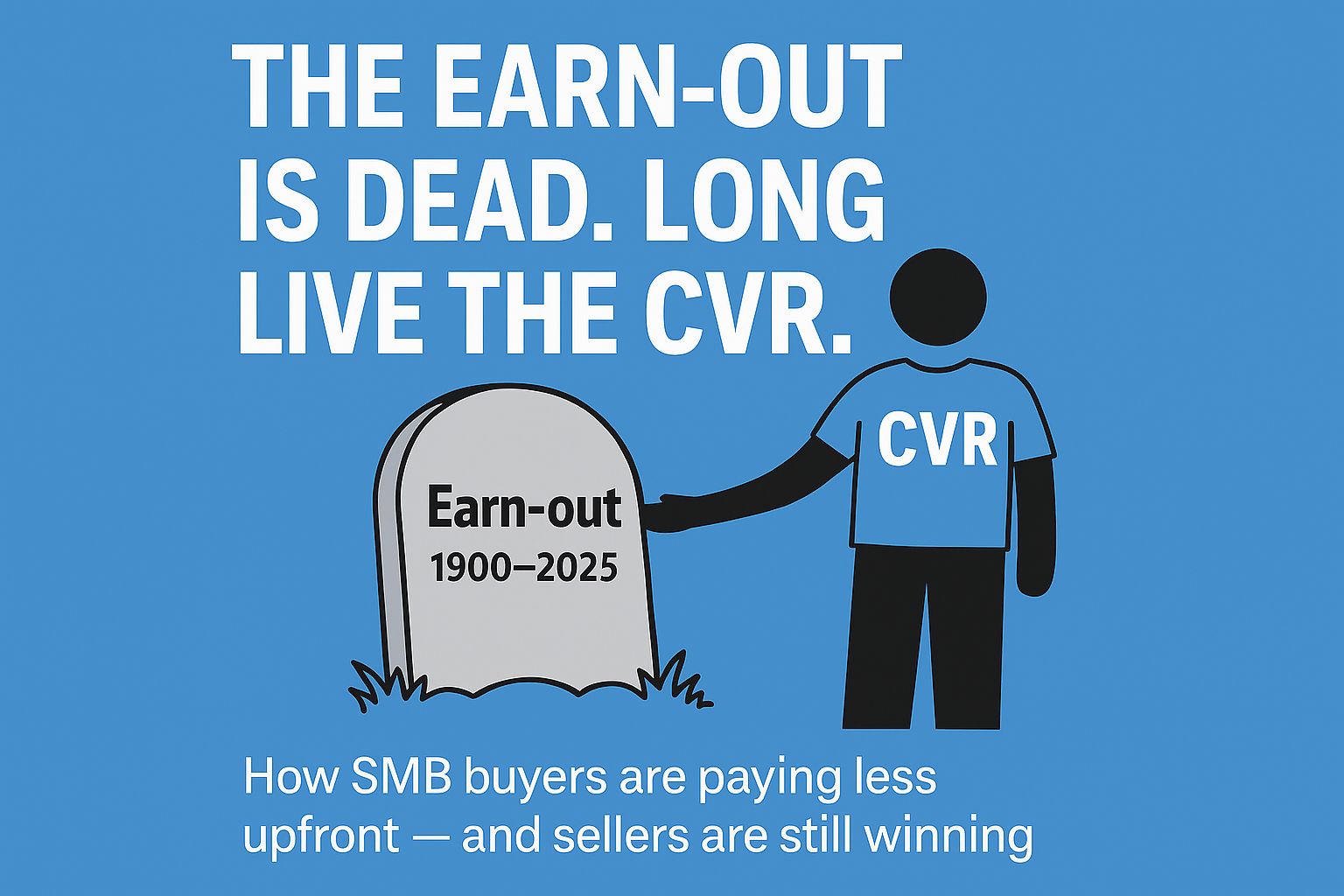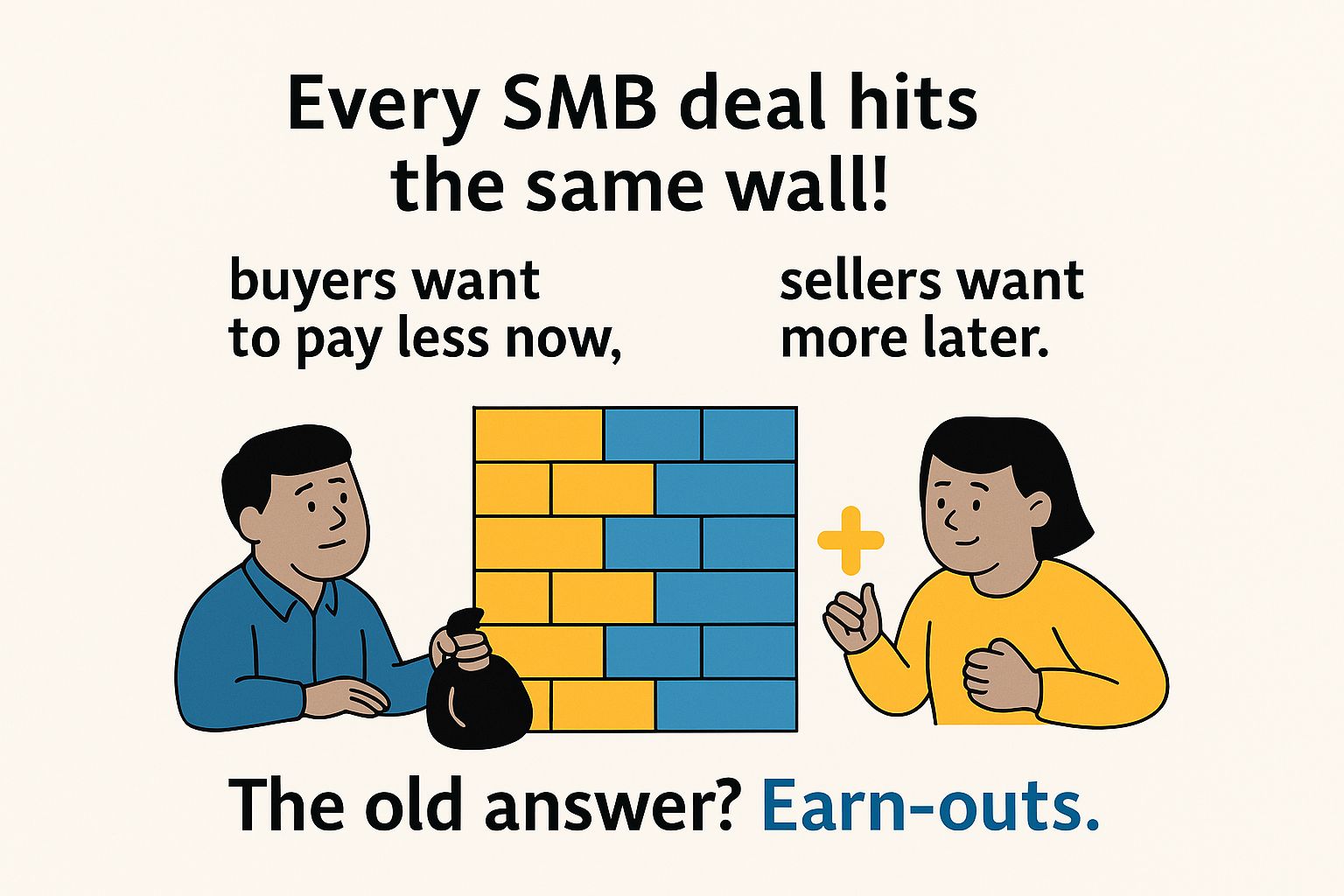- Roland’s Riff
- Posts
- Earn Outs Are Dead and Sellers Never Saw It Coming
Earn Outs Are Dead and Sellers Never Saw It Coming
EBITDA Is A Trap. Smart Buyers Use This Instead.
TLDR: Earn-outs are outdated and cause disputes over financial performance. Contingent Value Rights (CVRs) solve this by tying seller payouts to clear, verifiable events like contract renewals. Using a CVR + Earn-Out + Seller Note + SBA Loan, you can buy a $2.5M business with only $125K down. CVRs are binary, auditable, and SBA-friendly, giving sellers upside without post-close arguments. Buyers get leverage, lenders get clarity, and deals close faster. It’s the modern way to bridge valuation gaps, an earn-out you can actually collect.

The Earn-Out Is Dead. Long Live the CVR.
(How To Use a CVR + Creative Stack to Buy a $2.5M Company With Just $125K Out of Pocket)
The Big Idea
If you’re still using old-school earn-outs to bridge valuation gaps, you’re fighting yesterday’s deal war.
A new hybrid structure is emerging from the Wall Street playbook, the Contingent Value Right (CVR) and it’s quietly becoming the smartest way to buy more businesses with less cash and sell for more without waiting forever.

1. The Problem With Earn-Outs
Earn-outs were supposed to align incentives.
Instead, they’ve become litigation magnets.
They tie future payments to financial metrics like revenue or EBITDA, numbers that are easy to “interpret” when buyer and seller are no longer aligned.
In the SMB world, where accounting is inconsistent and buyers often change post-close operations, earn-outs create endless gray areas:
Did the buyer und
er-invest in marketing?
Did they shift expenses into this entity?
Did they change revenue recognition?
Each of those can tank the seller’s payout and trigger a fight.
2. The CVR: Earn-Out’s Smarter, Simpler Cousin
A Contingent Value Right (CVR) says:
“If this one thing happens, you get paid.”
That “one thing” could be:
a major contract renewal
a regulatory or licensing milestone
retention of key customers
successful integration or technology deployment
Unlike an earn-out, the CVR is binary (it happens or it doesn’t), auditable (you can verify it in data or documents), and bankable (clean enough to model and price into a deal).
🔍 In Plain English
Concept | Earn-Out | CVR |
Trigger | Financial performance | Specific event or milestone |
Control risk | High: buyer controls operations | Low: tied to verifiable outcome |
Duration | 1–3 years | Single event window |
Disputes | Frequent | Rare |
Accounting | Adjusts purchase price | Separate contingent right |
Best For | Gradual growth | One-off de-risking events |
The CVR is to earn-outs what AirPods are to wired headphones: same idea, dramatically better usability.
3. The Hybrid Stack: Cash + SBA + Seller Note + CVR + Earn-Out
Let’s look at a realistic small business acquisition to see how this works in practice.
The Deal
Target: HVAC Company
Total Enterprise Value (TEV): $2.5M
Traditional Buyer Financing: 100% cash or 80% SBA + 20% cash (≈$500K down)
Our Creative Stack: $125K out-of-pocket.
Here’s how we get to total potential consideration of $2.5M with total cash outlay at close of only $125,000.
Capital Source | Amount | Terms |
Seller Standby Note | $1,000,000 | Subordinated to SBA, interest-only 2 years, 6-year amortization |
SBA 7(a) Loan | $375,000 | 10-year term, 10.5% blended rate |
Cash Down | $125,000 | Buyer equity |
Earn-Out | $500,000 | Based on 12-month EBITDA target |
CVR | $500,000 | Triggered by city contract renewal |
Total Potential Consideration | $2.5M | (if both contingent pieces achieved) |
4. Why This Beats Traditional All-Cash or Cash+Bank Deals
a. Liquidity Leverage
Instead of tying up $500K+ in equity, you deploy $125K…freeing $375K in dry powder for your next deal.
b. Seller Alignment Without Micromanagement
The CVR lets the seller feel like they’re “still in the game”, but without giving them operational control. They get paid when a binary event they influence (like a contract renewal) happens, not based on subjective EBITDA numbers.
c. Lender Safety
SBA lenders love clean, capped contingencies. The CVR sits after the bank gets paid, so it doesn’t disrupt underwriting.
d. Valuation Flexibility
You can justify a higher nominal purchase price (appeasing sellers’ egos) while paying less upfront.
e. Auditability + Simplicity
The CVR milestone is verifiable by report or document, not judgment. No forensic accounting needed.
5. How We Structure It (Step-by-Step Deployment)
Step 1 — Identify Milestones That Matter
First pinpoint the biggest binary value driver: let’s say it’s a city maintenance contract up for renewal in 9 months. Without it, revenue drops 20%. With it, the valuation doubles.
✅ Perfect CVR trigger.
Step 2 — Define the CVR in the APA Exhibit
“Seller earns $500,000 if the City of Mesa contract is renewed for a minimum 12-month term within 9 months of Closing.”
Measurable (signed contract copy)
Bounded (single milestone, single timeframe)
Enforceable (defined report + audit clause)
Payable (ACH within 30 days of verification)
Step 3 — Layer in the Earn-Out
To cover ongoing performance, we added a $500K earn-out tied to maintaining $1M EBITDA in Year 1.
Keeps seller motivated post-close
Allows buyer to underwrite on base performance, not blue-sky projections
Payment due in 12 months, audited from financials
Step 4 — Capital Stack Integration
Then work with the SBA lender to ensure:
The seller standby note is properly subordinated.
The CVR and earn-out are treated as deferred purchase consideration, not debt.
Only the $125K cash + $375K SBA loan hit the initial closing ledger.
Step 5 — Post-Close Payoff Scenarios
Scenario | Triggered Events | Total Paid | Buyer IRR (Est.) | Explanation |
Base Case | Only core business, no earn-out or CVR | $1.5M (SBA + Note) | 39% IRR | Buyer only pays debt service; no contingents triggered. Excellent leverage efficiency. |
Mid Case | Earn-out achieved (EBITDA target hit), no CVR | $2.0M | 32% IRR | Seller benefits from performance, buyer still achieves strong ROI with low cash basis. |
Full Case | Earn-out + CVR both triggered | $2.5M | 26% IRR | Even at full payout, IRR remains high due to minimal equity down and deferred consideration. |
Even at full payout, the buyer’s effective leverage remains outstanding, turning a six-figure outlay into multi-million control.

6. Why This Works (And Why It’s Bankable)
✅ One Metric, One Window, One Payout.
Ambiguity kills CVRs; simplicity makes them collectible.
✅ Frozen Accounting + Audit Rights.
Protects both sides and passes lender due diligence.
✅ Deferred, Not Risky.
You’re not over-leveraged; you’re simply sequencing value delivery.
✅ Tax Efficient.
For sellers, CVR and earn-out payments are typically treated as capital gain if structured as purchase consideration, not compensation.
7. The North Star Takeaway
“A CVR is the earn-out you can actually collect.”
We’re using this across multiple deals now, pairing CVR + Earn-Out + Seller Standby to create low-cash, high-upside, frictionless acquisitions that both sides feel great about.
Final Thoughts
Most small business buyers obsess over funding the purchase.
The best ones design structures that fund themselves and de-risk the deal.
When you add the CVR to your toolkit, you stop negotiating price and start negotiating proof.
And proof, unlike EBITDA, doesn’t lie.
Behind the Scenes on Instagram
Want more than just the weekly deep dives? On Instagram we share quick tips, behind-the-scenes looks, and first access to what’s coming next.
📲 Follow @RolandFrasier on Instagram and join the community.

Thinking About Exiting Your Business?
You’ve built something incredible, now it’s time to make sure you get the most from your exit. We’ve helped countless entrepreneurs maximize their business sales, ensuring they walk away with more than just a deal, they walk away with the best deal possible.
Want to see what’s possible for you? Schedule a complimentary call (click here) today to see how I can help you get the most out of your exit.
Whats Going On
Recently On The Business Lunch Podcast: In this episode, we crack open the 2025 Forbes 400 and spot a seismic shift: 71% are now self-made, the cutoff is a record $3.8B, and the newest entrants aren’t entertainers or app celebrities, they’re infrastructure builders (data labeling, energy export, freight platforms, drive-thru formats). — Listen on Apple Podcasts I Spotify
Your Weekly M&A Coaching Call: Every week, I’m breaking down your toughest acquisition questions with actionable advice you can apply now. Watch the latest coaching call below.
Want to learn my full process?: Join me where I break down my entire, exact system, step-by-step, how deals are sourced, structured, funded, and closed. No theory, just proven strategy. Watch here.

The Riff
Before I touch a spreadsheet, I run every deal through 5 questions. If it fails even one, I'm out….these questions have killed acquisitions in under a minute - and saved me from deals that looked perfect on paper. 🤔 Watch to learn more


